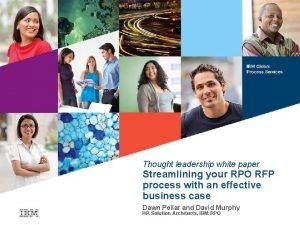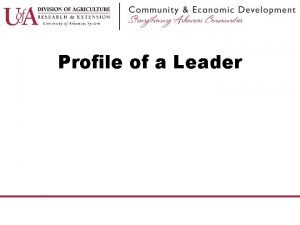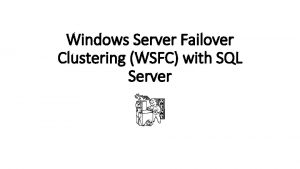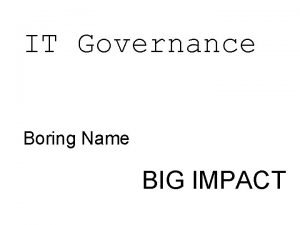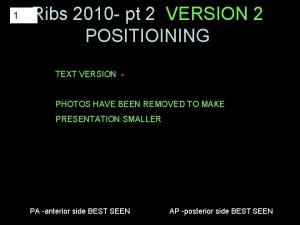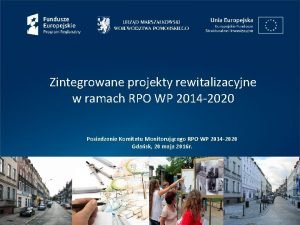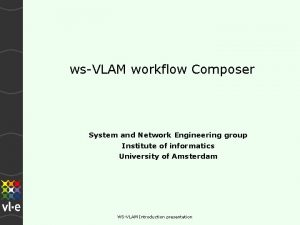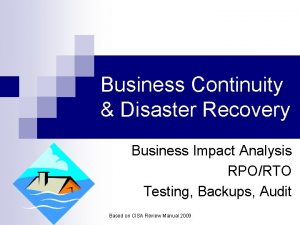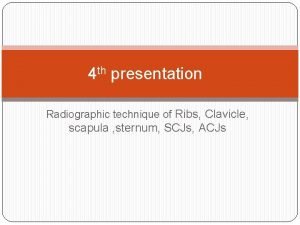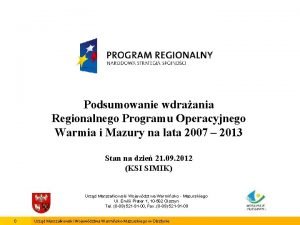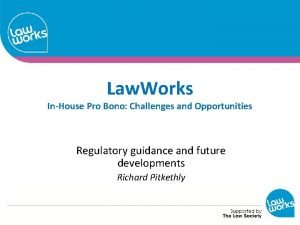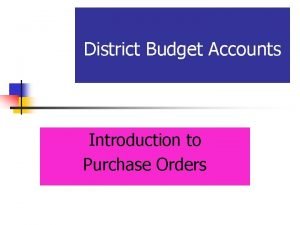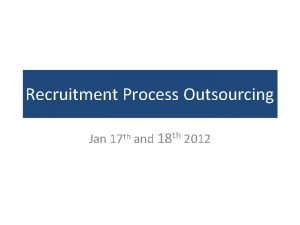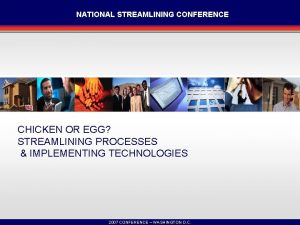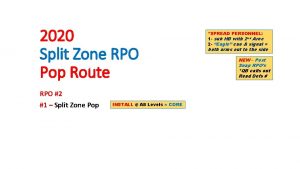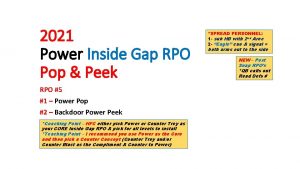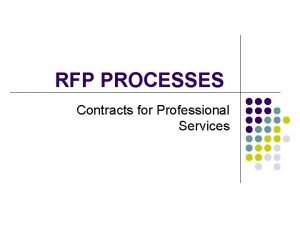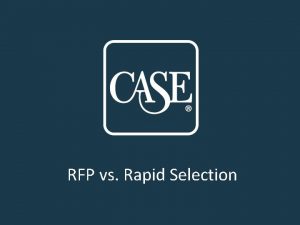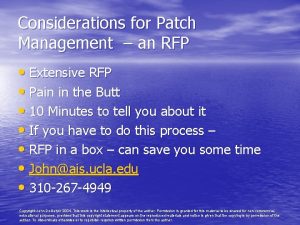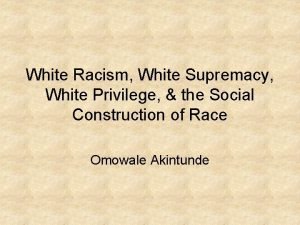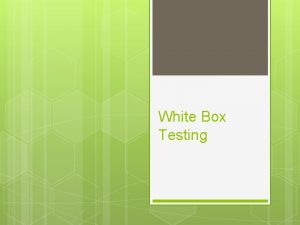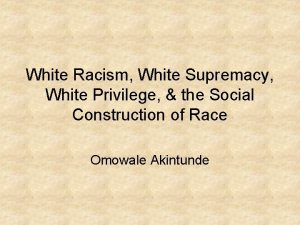Thought leadership white paper Streamlining your RPO RFP




















- Slides: 20

Thought leadership white paper Streamlining your RPO RFP process with an effective business case Dawn Pellar and David Murphy HR Solution Architects, IBM RPO

Today’s presenters Dave Murphy Dawn Pellar murphyrd@us. ibm. com dpellar@us. ibm. com +1 815 271 0864 +1 248 979 5950 Dave brings 20 years of experience in the staffing and recruiting industry both as a business development executive and a solution architect. As an IBM solution architect and certified personnel consultant, Dawn brings 25 years of experience in the staffing and recruiting industry. Dave has designed and led large RPO engagements and has broad experience in numerous industries including financial institutions, airline and travel, manufacturing, pharmaceutical, industrial and more. His experience in designing integrated global talent management solutions and services is broadening the IBM Talent Services offering. Dawn acts as a worldwide consultant designing global recruiting solutions, working with a network of worldwide colleagues and clients. She has developed and leads a global RPO exchange that shares best practices and lessons learned from around the globe. This powerful global RPO “think tank” meets regularly with RPO subject-matter experts to discuss RPO trends. Dave is a graduate of Harper College and has completed numerous training and education courses through accredited institutions. He resides in Johnsburg, Illinois with his wife Kathy. Dawn is a graduate of Ferris State University and has completed the executive training course at the Fuqua School of Business at Duke University. She also has a Global Business Management degree from the University of Phoenix. Dawn and her family reside in Murrells Inlet, South Carolina. © 2012 IBM Corporation 2

Agenda ► Welcome and introductions ► Talent acquisition trends ► Challenges in building a business case ► Collecting and understanding your data ► Overview and demo of IBM Recruiting Cost Modeler ► The talent acquisition transformation journey ► Presenting efficiencies and cost savings to leadership ► Questions © 2012 IBM Corporation 3

Polling question ► What is the total number of annual hires for your organization (exempt, non-exempt, university and executive)? 1. 0 -500 2. 501 -1000 3. 1001 -2000 4. 2001 -5000 5. 5001+ © 2012 IBM Corporation 4

Recruitment transformation: client trends ► Client conversations – Discussions lead from BPO to HRO to RPO ► RPO conversation trends – Recruiting “noise” • Not the right talent (quality and quantity) • Process is flawed (time, steps, technology, etc) • Candidate campaigns inadequate for focus skills (critical jobs going unfilled) • Employment brand inconsistencies (consistent, extension of culture) • Are candidates finding us versus are we finding candidates? – RFI / RFP initiative – Embedded in larger initiative • Process is imperfect • Talent Management is broader interest • Business case is not developed • Lack of sponsorship • No decision © 2012 IBM Corporation 5

Recruitment transformation: client solution ► Response – Provide a guideline • White paper and recruiting cost modeler – Smarter recruiting ► Preparation – Understand your business costs – Goal alignment – Executive sponsorship – Implications for TA team members – Impact on your business and geographical units ► How do you create and evaluate a business case to address these issues? © 2012 IBM Corporation 6

The importance of a holistic business case for recruitment transformation ► Your business case has a direct impact on your RFP ► Prospective providers need appropriate levels of information on how business needs are connected to the broader strategic vision ► When objectives lack specificity, RFP responses are not as refined as they should be ► Providers resort to submitting basic answers with generic lessons learned, as opposed to more dynamic solutions tailored to your business needs ► What will your recruiting organization look like in 5 or 10 years? The impact of your decisions today will shape your processes in the future. ► What roles will my key players have after transformation? ► Am I aligned with the senior executive vision of my organization’s future? © 2012 IBM Corporation 7

Ten factors to consider when developing an RPO business case 1. Set realistic expectations around the time and budget commitments needed to develop a business case 2. Identify an executive sponsor for the project 3. Recruiting is more than just technology 4. Understand how your retained organization’s role will evolve 5. Consider the impact of RPO across multiple business units and geographies 6. Ask yourself detailed questions to arrive at detailed objectives 7. Utilize an RPO cost analysis modeler 8. Use industry best practices to help you evaluate what processes to retain vs. what processes to outsource 9. Be sure that the ultimate goals of your business case align with the C-suite’s business objectives 10. Internal support for your business case increases the likelihood for a successful conclusion to your RFP © 2012 IBM Corporation 8

Understanding your data – the IBM Recruiting Cost Modeler ► How can you improve what you haven’t or can’t measure? – Provides a holistic analysis of your current-state recruiting program – Contributes to the development of a solid recruitment process outsourcing business case – Provides unique data (yours) to measure against in a credible process in which to base decisions for recruiting – Leverages intellectual capital and solution architect expertise gained over numerous engagements © 2012 IBM Corporation 9

Overview and demonstration of the IBM Recruiting Cost Modeler HR cannot conduct this effort alone – you are going to need input! Talent acquisition ► ► ► Hiring volume by location Number of resources that affect the recruiting process with salary information Hiring forecasts Referral program details Segment hiring into four categories: university, hourly, salary, executive Business leaders ► ► Hiring forecasts Critical job categories and key skills needed for growth Core competencies for new hires New market growth goals Procurement ► ► ► List of agencies with terms Technology contracts (job boards, applicant tracking system contracts, sourcing contracts, etc. ) Travel agreements (to determine costs for job fairs) Marketing and IT ► ► ► Marketing material costs for job fairs Display costs IT considerations Maintenance costs for ATS and recruiting technology Report writing costs for hiring analytics Importance of data collection, the value of analytics and being able to run “what if” scenarios © 2012 IBM Corporation 10

Polling question ► Do you know the cost per hire for your organization? 1. Yes 2. No © 2012 IBM Corporation 11

Demonstration of the IBM Recruiting Cost Modeler © 2012 IBM Corporation 12

Response – praise for the IBM Recruiting Cost Modeler and process “Recruiting has many arms and legs. It interacts with many aspects of the business. This Recruiting Cost Modeler helps me analyze where the costs are and what impact they have to areas outside of HR. ” – Global SVP of Human Resources, Manufacturing Company “The data from this Recruiting Cost Modeler is objective. This will allow me to present my business case with credible, fact-based evidence that supports my initiative. ” – VP of Human Resources, Consumer Products Organization “I wish we had this tool last year! We would have had a much more effective RFP process for RPO. It was difficult for my team to evaluate the responses without having a baseline of data to measure against. With this type of data we would have asked more specific questions from the providers. ” – CHRO, North American Retail Organization “This allows me to capture all my costs in one tool. The challenge has been pulling all the pieces together and analyzing the sum of the parts. The outcome provides clear data to make business decisions. ” – SVP, Global Airline Company © 2012 IBM Corporation 13

Summary of benefits to the IBM Recruiting Cost Modeler ► Provides a holistic analysis of your current recruiting program ► Contributes to the development of a solid recruitment process outsourcing business case ► Leverages intellectual capital and solution architect expertise gained over numerous engagements ► Logically analyzes costs in your recruiting organization – Hiring data – Recruiting costs – Staffing ► Provides you internal and external benchmarking options ► Builds a detailed view of people, process and technology ► Presents actionable outcomes © 2012 IBM Corporation 14

Polling question ► How do you benchmark your costs per hire? 1. We benchmark internally 2. We benchmark with external research 3. We do not benchmark © 2012 IBM Corporation 15

Talent acquisition transformation: How good do I need to be? 1. Talent acquisition process – Meeting the needs of the business – Adjust for varying business needs (white glove, volume hiring projects) – Cost per hire 2. Talent acquisition staff – The right resource for the activity – Strategic versus tactical – Involvement with business decisions 3. Technology – Enablement for recruiting – Create a technology ecosystem that helps you run talent acquisition © 2012 IBM Corporation 16

Talent acquisition transformation – it’s a journey Career Site Tour Corporate Finance Talent Landing Page Talent Community: Social Media ► How do we know we’re being successful? http: //jobs. client. com/talent community/subscribe/? utm _source=linkedin&utm_ca mpaign=Allie_TC_Linked. In 2011 Hires: – 70, 000 Talent Community ► Members ► http: //www. linkedin. com/gro ups=clientcareers ► http: //www. facebook. com/g eneralmotorscareers ► http: //twitter. com/ !/client. Careers ► http: //www. youtube. com/cli entcareers 1 http: //www. facesofgm. com/ ► – 4000 group members ► – 5900 followers – 650 followers ► ► 2011 Sourcing Traffic by Channel Average incubation time: 400. 6 days Only 19% of hires occur in the 1 st day of applying. 35% of hires occur from applying in the first 30 days of the talent community. 26% (589 total) of hires in 2011 were in the talent community for over 1 year before finally applying to the job they were hired into. Started 2011 with 10, 314 candidates in the talent community, ending the year at 68, 770 © 2012 IBM Corporation 17

How to present efficiencies and cost savings to leadership 1. Aligning talent acquisition to company goals – Do we have a sustainable / flexible talent acquisition model? – Do we have an integrated technology platform? – Have we leveraged innovation to streamline processes? 2. Cost savings – Do we have a clear understanding of where our costs are today? – Do we understand the impact of building a new infrastructure? – Can we show year-over-year cost savings as the new model is implemented? 3. Process efficiency – Do we have the “right” resources doing the work? – Do we have harmonized systems? – Are we leveraging technology and innovation? © 2012 IBM Corporation 18

Question and answer exchange Dave Murphy Dawn Pellar murphyrd@us. ibm. com dpellar@us. ibm. com +1 815 271 0864 +1 248 979 5950 Fragen? Questions? Frågor? ��� ? Le domande? ¿Las preguntas? ﺃﺴﺌﻠﺔ؟ © 2012 IBM Corporation 19

Thank you!
 Rpo white paper
Rpo white paper Complete or incomplete thought?
Complete or incomplete thought? Metaphor in the fish poem
Metaphor in the fish poem Leader ki paribhasha
Leader ki paribhasha Wsfc sql
Wsfc sql Bompk
Bompk Projection
Projection Rpo pomorskie
Rpo pomorskie Rpo workflow composer
Rpo workflow composer Mttr vs rto
Mttr vs rto Rpo lpo
Rpo lpo Rporto
Rporto Rpo ribs
Rpo ribs Rpo warmia i mazury
Rpo warmia i mazury Inhouse rpo
Inhouse rpo Hudson rpo australia
Hudson rpo australia Rpo purchase order
Rpo purchase order Outsourcing definition tutor2u
Outsourcing definition tutor2u Rpo pomorskie
Rpo pomorskie Nnn poem
Nnn poem Ellen g white henry nichols white
Ellen g white henry nichols white
